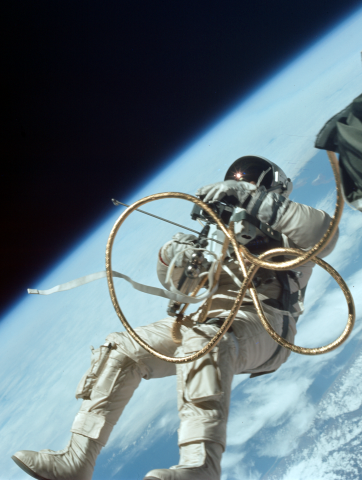Gemini Program History

Ed White floating free of the Gemini IV capsule on 3 June 1965.
The Gemini program (1964 to 1966), was conceived after it became evident to NASA officials that an intermediate step was required between Project Mercury and the Apollo program. The Gemini program was designed to test technologies and techniques for the Apollo program. The two-man Gemini spacecraft was larger and more sophisticated than its Mercury predecessor. The major objectives assigned to Gemini according to the Kennedy Space Center were:
- To test an astronaut's ability to fly long-duration missions (up to two weeks in space).
- To understand how spacecraft could rendezvous and dock in orbit around the Earth and the moon.
- To perfect re-entry and landing methods.
- To further understand the effects of longer space flights on astronauts
A brief summary of the Gemini flight results reveals how successful the Gemini program was. All of the major objectives were met as well as many other objectives assigned to each mission.
The spacecraft was designed by a team of NASA engineers led by Jim Chamberlin, and built by McDonnell Aircraft, in St. Louis. There were two uncrewed test flights and 10 crewed flights - all launched on a Titan II missile. The Gemini flights helped NASA learn to work and live in space, paving the way for the successful Apollo human landings on the Moon.
Space firsts from the Gemini program include:
- First onboard computer
- First rendezvous (Gemini VI-A with Gemini VII)
- First docking of crewed and uncrewed spacecraft (Gemini VIII with Agena)
- First propulsion maneuver with docked Agena (Gemini X)
- First maneuver to change orbit plane
- First working EVA
Summary of the Gemini program
- Gemini III: 23 March 1965, first crewed flight.
- Gemini IV: 3-7 June 1965, first EVA.
- Gemini V: 21-29 August 1965, first week-long flight, first fuel cells.
- Gemini VII: 4-18 December 1965, first rendezvous with crewed vehicle (Gemini VI-A).
- Gemini VI-A: 15-16 December 1965, first rendezvous with crewed vehicle (Gemini VII).
- Gemini VIII: 16-17 March 1966, first docking (Agena target vehicle).
- Gemini IX-A: 3-6 June 1966, third rendezvous.
- Gemini X: 18-21 July 1966, first use of docked Agena to propel Gemini spacecraft.
- Gemini XI: 12-15 September 1966, docking and maneuvering with Agena, altitude record.
- Gemini XII: 11-15 November 1966, first fully successful EVA (2 hours 6 minutes).